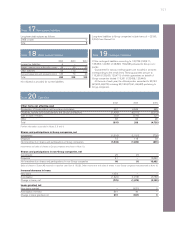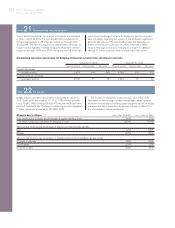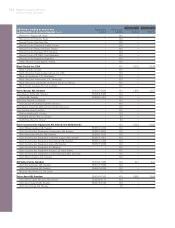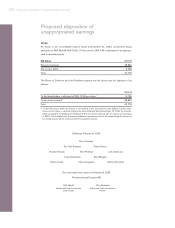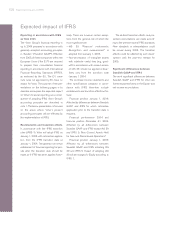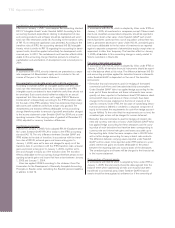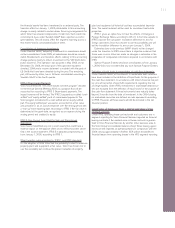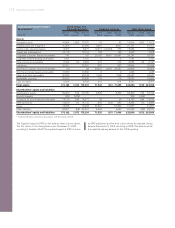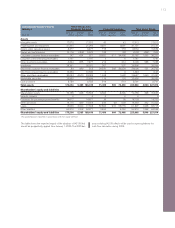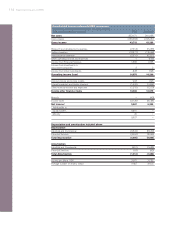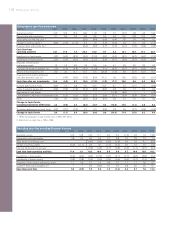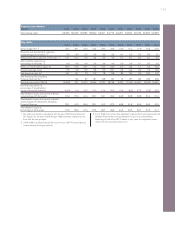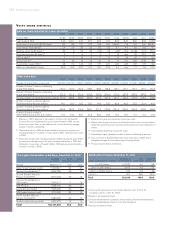Volvo 2004 Annual Report Download - page 113
Download and view the complete annual report
Please find page 113 of the 2004 Volvo annual report below. You can navigate through the pages in the report by either clicking on the pages listed below, or by using the keyword search tool below to find specific information within the annual report.
111
the financial assets has been transferred to an external party. The
transition effect on January 1, 2005, attributable to this accounting
change is mainly related to certain dealer financing arrangements for
which Volvo has retained components of credit risk. Such credit risk
commitments have under Swedish GAAP been reported as contin-
gent liabilities. This will mainly affect the segment reporting and to a
less extent Volvo’s consolidated balance sheet.
Consolidation of temporary investments:
Under Swedish GAAP, temporary investments in subsidiaries should
not be consolidated. Under IFRS, all subsidiaries should be consoli-
dated. Restatements and transition effects relating to this accounting
change pertains mainly to Volvo’s investment in the “LB Smith distri-
bution business”. This operation was acquired in May 2003 and at
December 31, 2004, the major part of this operation had been
divested. 2004 year’s income statement is restated with the parts of
LB Smith that have been divested during the year. The remaining
part, still owned by Volvo, has in full been consolidated according to
Swedish GAAP in the fourth quarter.
IFRS 2 Share-based Payments
Volvo has defined the “new stock-based incentive program” decided
on the Annual General Meeting 2004 as a program that will be
accounted for according to IFRS 2 Share-based payments. The
impact however will be limited. The IFRS 2 separates so-called “cash-
settled” and “equity-settled” parts of share-based payments. The
Volvo program includes both a cash-settled and an equity-settled
part. The equity-settled part was earlier accounted for at fair value
and provided for as an accrued expense over the vesting period with
a “true up” each reporting date. According to IFRS 2 the fair value is
determined at the grant-date, recognised as an expense during the
vesting period and credited to equity.
IFRS 5 Non-Current Asset Held for Sale and Discontinued
Operations:
Volvo has not identified any non-current assets that could have a
material impact on the balance sheet and no effect has been identi-
fied in the income statement. IFRS 5 is adopted prospectively as
from January 1, 2005, according to IFRS 1.
Other transition rules according to IFRS 1 and IFRS standards
On the adoption of IFRS Volvo had the possibility to elect to measure
property, plant and equipment at fair value. Volvo has chosen not to
use this possibility but continue the present valuation of property,
plant and equipment at historical cost less accumulated deprecia-
tions. The same treatment will be used for investment real estate
properties.
IFRS 1 gives an option how to treat the effects of Changes in
Foreign Exchange Rates, according to IAS 21. A first time adopter to
IFRS could set the cumulative translation difference to zero for
foreign operations. Volvo has chosen to use this possibility and will
set the translation difference to zero as per January 1, 2004.
Estimates done under previous GAAP should not be changed
under the transition to IFRS unless there is objective evidence that
those were in error. Volvo has made no changes in estimates in the
preparation of comparative information prepared in accordance with
IFRS.
Special Purpose Entities should be consolidated as from January
1, 2004. Volvo has not indentified any such Special Purpose Entities.
Definition of liquid funds in presentation of cash-flow statements:
Under Swedish GAAP, all investments in marketable debt securities
have been included in the definition of liquid funds for the purpose of
the cash-flow statement. In accordance with Volvo’s financial risk pol-
icy, all such securities should fulfil requirements regarding low risk
and high liquidity. Under IFRS, investments in marketable debt securi-
ties are excluded from the definition of liquid funds for the purpose of
the cash-flow statement if these instruments have maturity dates
beyond 3 months from the date of investment. In the 2004 closing
no marketable securities are defined as cash equivalents according
to IFRS. However, all these assets will still be included in the net
financial position.
Classification of leasing contracts in segment reporting of Volvo
Financial Services:
Under IFRS, operating lease contracts with end customers are in
segment reporting for Volvo Financial Services reported as financial
leasing contracts if the residual value in these contracts is guaran-
teed to Volvo Financial Services by another Volvo business area. In
the Volvo Group’s consolidated balance sheet, these leasing agree-
ments are still reported as operating leases. In comparison with the
2004 closing approximately 13 billion SEK will be reclassified to
financial leases from operating leases in the VFS segment reporting.


